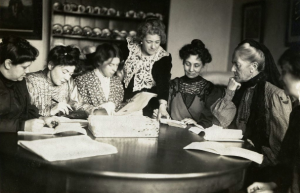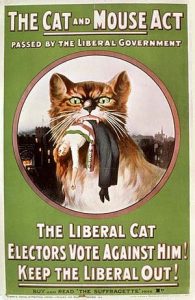Women’s Social and Political Union (WSPU) (1903-1917)
“We shall fight against the condition of affairs, so long as life is in us” – Emmeline Pankhurst
Despite the social expectations that women be submissive and silent, in 1903, British women founded the Women’s Social and Political Union (WSPU). It all began in the Pankhurst’s family home with a small gathering of women. At first, none of the women held any leadership positions because of their desire to have elected government officials—all of whom were men. However, Emmeline Pankhurst and her two daughters, Christabel and Sylvia, became the major leaders who dictated the activities of the organization. These women were unhappy with the poor results of the existing National Union of Women’s Suffrage Societies, and they strongly believed that their tactics of persuasion and lobbying were useless.
The WSPU became an exclusively women’s organization fighting to obtain women’s suffrage by all means necessary. This does not mean that they did not have male supporters. In reality, many men wanted new social reforms that would spread to women and help them. The organization’s first efforts were directed at persuading politicians to pass bills that would support women’s suffrage in 1905. Though they were met with opposition, with this stunt, they gained publicity and the group began to grow. The organization began to use the colors white, purple, and green as well as use the slogan “deeds, not words.” In response to the lack of support from the government, they would show great opposition to political parties that did not support their women’s agenda.
Soon after, the WSPU developed militant tactics, which for women was very unexpected during this time. These militant tactics included demonstrations, destruction of property, and lobbying. The leaders of the organization strongly believed that with the use of militant tactics they would be able to draw attention to their social needs as women. While these women did not harm civilians with the use of militant tactics, militant action—especially from women—was uncommon at this time. Many windows were broken, some buildings were set on fire, and women gathered in large crowds. The British government did not support their unruly behavior because women were expected to stay in the home and patiently await a change. As a result, the British government began to arrest many of the WSPU members.
However, these women were not stopped by imprisonment. Instead, they began to organize hunger strikes in protest of the continuous imprisonment of their members. While in prison, these women combatted terrible conditions as a result of tight quarters and poor sanitation. When their hunger strikes began, they also had to overcome force-feeding by the prison guards. The British government eventually passed the Prisoner’s Act in 1913, which allowed women who were near death or very unhealthy to leave the prison. To prevent as well as protect the women from returning to prison, the WSPU organized a Bodyguard team. These teams of women were willing to help their co-members even if it required using militant tactics and violence. Even though it may have been shocking to the government as well as the public, these women were passionately and proactively seeking a change not only through harming other objects but also themselves.
At beginning of World War I, the WSPU, primarily led by Christabel Pankhurst, began to actually show nationalist sentiments and work with the British government. They began to urge women to help or contribute in the war by either joining the industry production or volunteering. Many of the female participants followed this example and moved to these occupations. The WSPU was no longer drawing in the public’s attention because they were complying with the needs of society. Without the public’s attention, the organization dissolved in 1917.
The WSPU set an example for women in many other countries, which eventually resulted in women gaining the right to vote. It is eye opening to see the extreme actions and situations, which the women were willing to participate in, in order to gain women’s suffrage. Women, who had chosen peaceful methods, had few results and were often ignored by society. However, the WSPU, who used militant tactics, moved in the correct direction by forcing society to pay attention to women’s needs. The organization shows that to create social change a person must be willing to challenge social norms through any means necessary.
Carina Ochoa, Chemistry and Women’s and Gender Studies, Class of 2018
Sources
Literature and Websites
- “Emmeline Pankhurst ‘Why We Are Militant’ in Lives and Voices: Sources in European Women’s History, ed. Lisa DiCarpio and Merry E. Wiesner, 387-392. Boston: Houghton Mifflin Company, 1982.
- “Emmeline Pankhurst.” Biography, at https://www.biography.com/people/emmeline-pankhurst-9432764 (Accessed 9 April 2018)
- “Women’s Social and Political Union.” Wikipedia, at https://en.wikipedia.org/wiki/Women%27s_Social_and_Political_Union (Accessed 9 April 2018)
- Fuchs, Rachel and Victoria Thompson. Women in Nineteenth-Century Europe, 167-169. Basingstoke and New York: Palgrave Macmillan, 2005.
- Mayhall, Laura E. Nym,The Militant Suffrage Movement: Citizenship and Resistance in Britain, 1860-1930, 98-116. Oxford: Oxford University Press, 2003.
- Rosen, Andrew. Rise Up, Women!, 45-78. London and New York: Routledge, 2013.



